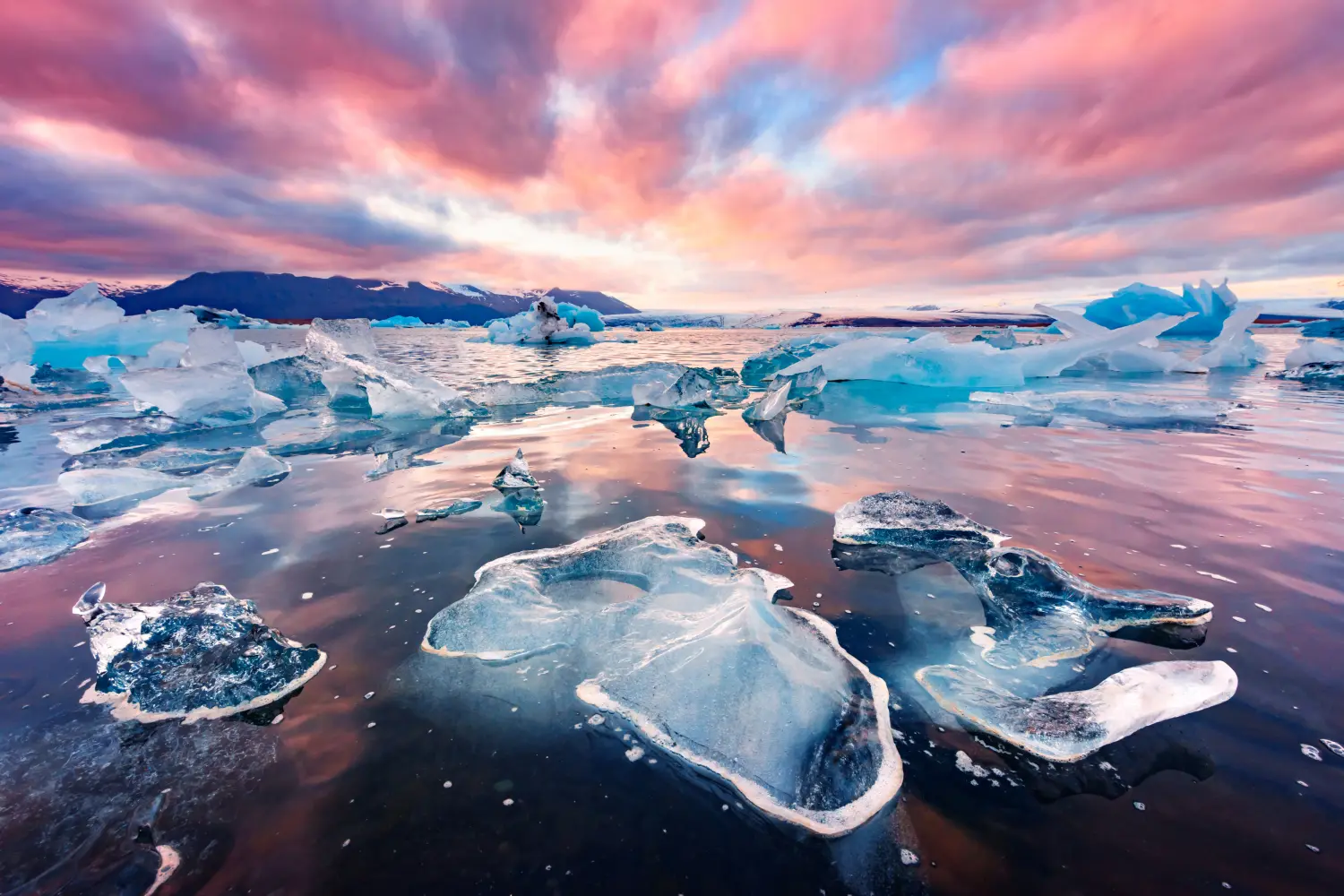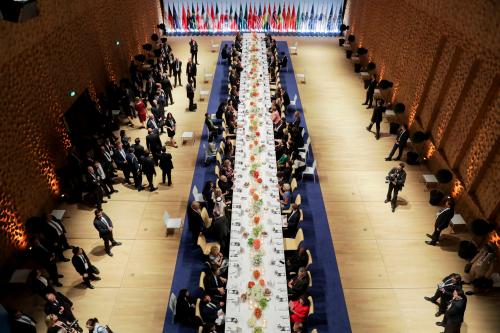Read translated versions of the report in Danish, French, and West Greenlandic.
Executive summary
This report explores China’s internal discourse on the Arctic as well as its activities and ambitions across the region. It finds that China sometimes speaks with two voices on the Arctic: an external one aimed at foreign audiences and a more cynical internal one emphasizing competition and Beijing’s Arctic ambitions. In examining China’s political, military, scientific, and economic activity — as well as its coercion of Arctic states — the
report also demonstrates the seriousness of China’s aspirations to become a “polar great power.”1 China has sent high-level figures to the region 33 times in the past two decades, engaged or joined most major Arctic institutions, sought a half dozen scientific facilities in Arctic states, pursued a range of plausibly dual-use economic projects,
expanded its icebreaker fleet, and even sent its naval vessels into the region. The eight Arctic sovereign states — Canada, Denmark, Finland, Iceland, Norway, Russia, Sweden, and the United States — exercise great influence over the Arctic and its strategically valuable geography. China aspires to be among them.
The report advances several primary findings:
1
China seeks to become a “polar great power” but downplays this goal publicly. Speeches by President Xi Jinping and senior Chinese officials with responsibility for Arctic policy are clear that building China into a “polar great power” by 2030 is China’s top polar goal. Despite the prominence of this goal in these texts, China’s externally facing documents — including its white papers — rarely if ever mention it, suggesting a desire to calibrate external perceptions about its Arctic ambitions, particularly as its Arctic activities become the focus of greater international attention.
2
China describes the Arctic as one of the world’s “new strategic frontiers,” ripe for rivalry and extraction.2 China sees the Arctic — along with the Antarctic, the seabed, and space — as ungoverned or undergoverned spaces. While some of its external discourse emphasizes the need to constrain competition in these domains, several others take a more cynical view, emphasizing the need to prepare for competition within them and over their resources. A head of the Polar Research Institute for China, for example, called these kinds of public spaces the “most competitive resource treasures,” China’s National Security Law creates the legal capability to protect China’s rights across them, and top Chinese Communist Party (CCP) officials have suggested China’s share of these resources should be equal to its share of the global population.3
3
Chinese military texts treat the Arctic as a zone of future military competition. Although several externally facing Chinese texts downplay the risk of military competition in the Arctic, which would likely be harmful to Chinese goals, military texts take the opposite perspective. They note that, “the game of great powers” will “increasingly focus on the struggle over and control of global public spaces” like the Arctic and Antarctic and argue that China “cannot rule out the possibility of using force” in this coming “scramble for new strategic spaces.”4 Chinese diplomats describe the region as the “new commanding heights” for global military competition too while scholars suggest controlling it allows one to obtain the “three continents and two oceans’ geographical advantage” over the Northern Hemisphere.5
4
Chinese texts make clear that its investments in Arctic science are intended to buttress its Arctic influence and strategic position. Although externally facing messaging indicates China’s desire to pursue scientific research for its own benefit and for global welfare, China’s top scientific figures and high-level CCP members are clear that science is also motivated by a drive for “the right to speak,” for cultivating China’s “identity” as an Arctic state, and for securing resources and strategic access.6 China’s polar expeditions and various research stations assist Beijing with its resource extraction, with Arctic access, and with acquiring experience operating in the Arctic climate.
5
China supports existing Arctic governance mechanisms publicly but complains about them privately. Several Chinese texts indicate frustration with Arctic mechanisms and concern that the country will be excluded from the region’s resources. Official texts suggest gently that the region’s importance now transcends “its original inter-Arctic States,” while scholars once feared Arctic states would launch an admittedly unlikely “eight-state polar region alliance” or institutionalize the Arctic Council in ways that “strengthen their dominant position” at China’s expense.7 These texts stress China’s pursuit of “identity diplomacy,” namely, terming China a “near-Arctic State” because it is affected by climate change.8 They also indicate an interest in pushing alternative Chinese governance concepts — in some cases to supplement and other cases to run outside the Arctic Council — including a “Polar Silk Road” and China’s “community with a shared future for mankind,” though specifics are often lacking.9
6
Accommodating China’s Arctic ambitions rarely produces enduring goodwill. Norway was the first country to allow China to build an Arctic science station and Sweden was the first worldwide to allow China to build its own completely China-owned satellite facility. Both these efforts, which were richly praised by China at the time, did not protect either country from later economic coercion and harsh condemnation by China. In both cases, China punished these countries not only for the actions of their governments but also for the independent actions of their civil societies, which were to award Chinese dissident Liu Xiaobo the Nobel Peace Prize and to investigate China’s kidnapping of Swedish citizen Gui Minhai. Efforts by both Norway and Sweden to reverse the slide — with Sweden keeping relatively quiet about the rendition of its citizen and Norway vigorously backing China’s pursuit of Arctic Council observer status — were only met with restrictions on Norwegian fish exports and colorful threats of coercion against Sweden.
7
Arctic dependence on trade with China is often overstated, and trade flows are smaller than with other powers. Chinese economic statecraft is feared by some in the Arctic and around the world, but the region’s dependence on China is remarkably small. For the five smallest Arctic economies — Sweden, Norway, Denmark, Finland, and Iceland — China accounts for an average of only 4.0% of their exports, less than the United States (6.2%) and far less than the NATO and EU economies excluding the United States (70.3%).10
8
China has invested significantly in Arctic diplomacy to boost its regional influence. China has sent high-level figures — at the levels of president, premier, vice president, foreign minister, and defense minister — to visit Arctic countries other than the United States and Russia 33 times over the last 20 years. Beijing lobbied heavily to become an Arctic Council observer, became a strong presence at many other regional Track II fora, and launched its own diplomatic and Track II regional efforts, including a China-Russia Arctic Forum and the China-Nordic Arctic Research Center, to deepen relations with governments and sub-national actors.
9
China’s military profile in the Arctic has increased, and its scientific efforts provide strategic advantages too. China has dispatched naval vessels to the Arctic on two occasions, including to Alaska and later to Denmark, Sweden, and Finland for goodwill visits. It has built its first indigenously produced icebreaker, has plans for more conventional heavy icebreakers, and is considering investments in nuclear-powered icebreakers too.
10
China’s scientific activities in the Arctic give it greater operational experience and access. China has sent 10 scientific expeditions into the region on its Xuelong icebreaker, generally with more than 100 crew members, that officials acknowledge give it useful operational and navigational experience. China has also established science and satellite facilities in Norway, Iceland, and Sweden while pursuing additional facilities in Canada and Greenland — with its facility in Norway able to berth more than two dozen individuals and provide resupply. Finally, China has used the Arctic as a testing ground for new capabilities whether related to satellites coverage, fixed-wing aircraft, autonomous underwater gliders, buoys, and even an “unmanned ice station” configured for research.
11
China’s infrastructure investments in the Arctic sometimes appear dual-use. Several Chinese infrastructure projects that have little economic gain have raised concerns about strategic motivations and dual-use capabilities. These include efforts by a former Chinese propaganda official to purchase 250 square kilometers of Iceland to build a golf course and airfield in an area where golf cannot be played and later to buy 200 square kilometers of Norway’s Svalbard archipelago. Chinese companies have also sought to purchase an old naval base in Greenland; to build three airports in Greenland; to build Scandinavia’s largest port in Sweden; to acquire (successfully) a Swedish submarine base; to link Finland and the wider Arctic to China through rail; and to do the same with a major port and railway in Arkhangelsk in Russia.
12
China’s commodity investments in the Arctic have a mixed track record. Despite some important successes, a large number of Chinese investments have failed. For example, a major Chinese firm abandoned a Canadian zinc mine, refused to pay creditors, and left local governments to pay to clean up an environmental disaster. Another firm disappointed in its investment later sued, saying it had overpaid. In Greenland, a Chinese conglomerate abandoned its iron mine after running into legal trouble in China. In Iceland, a Chinese company withdrew from an Arctic exploration partnership due to poor initial resource estimates.
Dansk
De otte uafhængige arktiske stater har stor indflydelse på Arktis og områdets strategisk værdifulde beliggenhed. Kina stræber efter at være blandt dem. Denne rapport udforsker Kinas interne diskurs om Arktis samt deres aktiviteter og ambitioner i hele regionen.
Download hele rapporten (pdf) »
Français
Les huit États souverains de l’Arctique exercent une grande influence sur l’Arctique et sa géographie stratégiquement intéressante. La Chine aspire à une place parmi eux. Ce rapport explore le discours interne des autorités chinoises sur l’Arctique ainsi que les activités et ambitions de la Chine dans toute cette région.
Télécharger le rapport complet (PDF) »
Télécharger le document (PDF) »
Kalaallisut kitaamiusut
Issittumi nunat namminersortut arfineq-pingasuusut Issittumut nunataanilu pilersaarusiornermut naleqartumut annertuumik sunniuteqarluarput. Kina taakkununnga ilanngukkusuppoq. Nalunaarummi matumani Kinap Issittumi suliniutitut angorusutatullu siunniussai misissuataarneqarput.
Nalunaarusiaq tamakkerlugu qarasaasiamut toqqoruk (PDF) »
Tunniussuunneqartussaq qarasaasiamut toqqoruk (PDF) »
This report was completed before Rush Doshi’s and Alexis Dale-Huang’s government service, involves only open sources, and does not necessarily reflect the official policy or position of any agency of the U.S. government.
-
Acknowledgements and disclosures
The authors would like to thank the China Strategy Initiative’s Working Group, especially co-chair Jacob Helberg, for its support of this project and Bruce Jones for reviewing earlier drafts of the report and providing invaluable feedback. Ted Reinert edited this paper, Chris Krupinski provided layout, and Rachel Slattery provided web design. Nikhita Salgame helped build the trade database this paper relies on, and Zijin Zhou and Isabella Lu also provided initial research assistance. Brookings is grateful to the U.S. Department of State and the Institute for War and Peace Reporting for funding this research.
-
Footnotes
- For examples, see “陈连增副局长主持中国极地考察工作咨询委员会第13次会议并讲话” [Deputy Director Chen Lianzeng Presided over the 13th Meeting of the China Polar Expedition Advisory Committee and Delivered a Speech], 华夏经纬网 [Huaxia], June 14, 2011, http://www.huaxia.com/hxhy/hyxw/2011/06/2453010.html; “海洋局局长:从极地大国迈向极地强国” [Director of the Oceanic Bureau: From a polar power to a polar superpower], 中央政府门户网站 [The Chinese Central Government’s Official Web Portal], November 19, 2014, http://www.gov.cn/xinwen/2014-11/19/content_2780849.htm; and Anne-Marie Brady, China as a Polar Great Power (Washington, DC: Woodrow Wilson Center Press, 2017), 3.
- For an example, see “合作才能避免失序” [Cooperation to Avoid Disaster], 中工网 [Zhonggongwang], May 12, 2014, http://world.workercn.cn/63/201405/12/140512054028106.shtml. This piece was written by Tang Yongsheng, the executive deputy director of the National Defense University’s Strategic Research Institute.
- “本报记者专访中国极地研究中心副主任杨惠根博士我国酝酿环球考察” [Our Reporter Interviewed Dr. Yang Huigen, Deputy Director of the China Polar Research Center, My Country Is Preparing for a Global Expedition], 新闻中心 [Sina], December 5, 2005, http://news.sina.com.cn/s/2005-12-05/00437617786s.shtml.
- 战略学 (2013年版) [The Science of Military Strategy] (Beijing: 军事科学出版社 [Military Science Press], 2013), 16, https://fas.org/nuke/guide/china/sms-2013.pdf, 74, 105-6.
- 郭培清 [Guo Peiqing], “郭培清:中国在北极没土地,但有利益” [Guo Peiqing: China Has No Land in the Arctic, but It Has Benefits], 环球网 [Huanqiu Wang], April 29, 2016, https://opinion.huanqiu.com/article/9CaKrnJV498; 唐国强 [Tang Guoqiang], “北极问题与中国的政策” [Arctic Issues and China’s Policies], 国际问题研究 [International Studies] (2013), CNKI: D993.5.
- For an example, see 郭云青 [Guo Yunqing], “探秘中国南极新站选址” [Exploring the Location of China’s New Antarctic Station], 人民日报 [People’s Daily], January 14, 2013, http://world.people.com.cn/n/2013/0114/c157278-20186013.html.
- “Full Text: China’s Arctic Policy,” (Beijing: The State Council of the People’s Republic of China, January 26, 2018), http://english.www.gov.cn/archive/white_paper/2018/01/26/content_281476026660336.htm; “‘极地未来对中国影响重大’ ——专访中国海洋大学极地问题专家郭培清” [The Future of the Polar Regions Will Have a Significant Impact on China’ – Interview with Guo Peiqing, an Expert on Polar Issues at Ocean University of China], 上海市科学技术协会 [Shanghai Association for Science & Technology], July 10, 2008, http://sast.gov.cn/view/8013.html; and 程保志 [Cheng Baozhi], “试析北极理事会的功能转型与中国的应对策略” [On the Functional Transformation of the Arctic Council and China’s Countermeasures], 国际论坛 [International Forum] 15, no. 3 (2013), CNKI: D815.3.
- 孙凯 [Sun Kai] and 武珺欢 [Wu Junhuan], “北极治理新态势与中国的 深度参与战略” [The New Situation of Arctic Governance and China’s Deep Participation Strategy] 国际展望 [Global Review] no. 6 (2015): 75, http://www.siis.org.cn/shgjwt201512107417/UploadFiles/file/20161223/201506007%20%E5%AD%99%20%20%20%20%E5%87%AF.pdf.
- “Full Text: China’s Arctic Policy,” The State Council of the People’s Republic of China. Also see杨剑 [Yang Jian] and 郑英琴 [Zheng Yingqin], “‘人类命运共同体’思想与新疆域的国际治理” [The Idea of ‘Community of Shared Future for Mankind’ and International Governance in New Frontiers], 上海国际问题研究院 [Shanghai Institutes for International Studies], October 10, 2017, http://www.siis.org.cn/Research/Info/4256.
- 2019 data from UN Comtrade Database, https://comtrade.un.org/.









